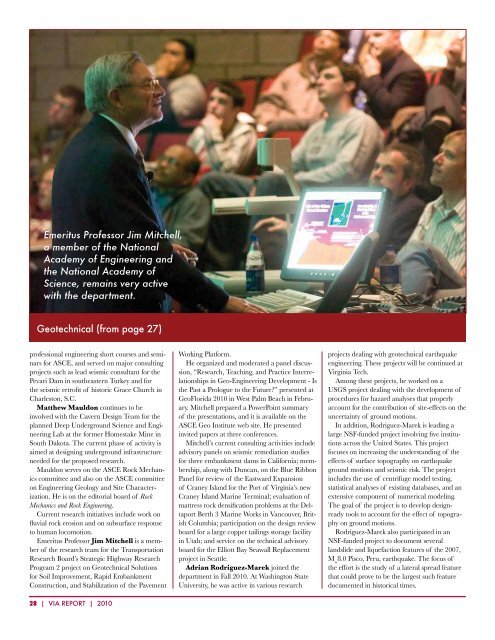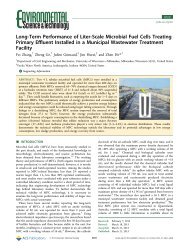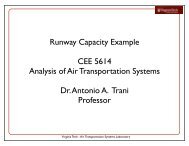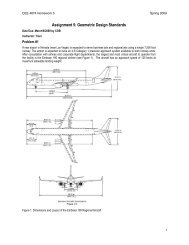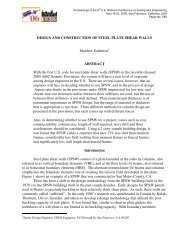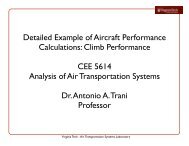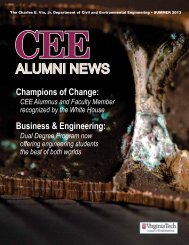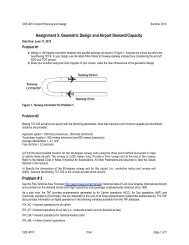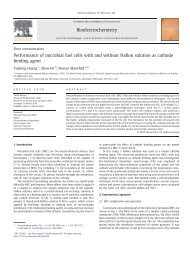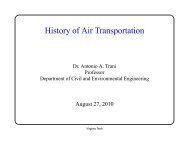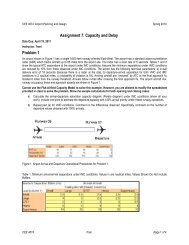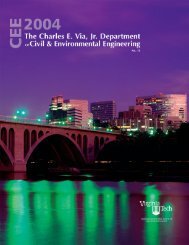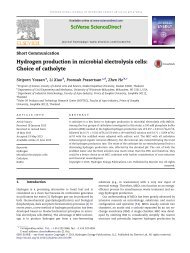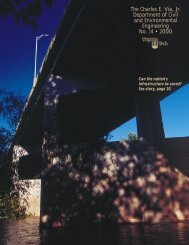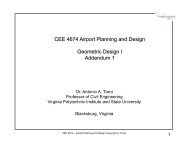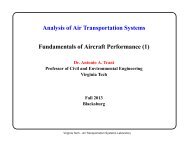Annual Report Year 2010 - Civil and Environmental Engineering
Annual Report Year 2010 - Civil and Environmental Engineering
Annual Report Year 2010 - Civil and Environmental Engineering
- No tags were found...
You also want an ePaper? Increase the reach of your titles
YUMPU automatically turns print PDFs into web optimized ePapers that Google loves.
Emeritus Professor Jim Mitchell,<br />
a member of the National<br />
Academy of <strong>Engineering</strong> <strong>and</strong><br />
the National Academy of<br />
Science, remains very active<br />
with the department.<br />
Geotechnical (from page 27)<br />
professional engineering short courses <strong>and</strong> seminars<br />
for ASCE, <strong>and</strong> served on major consulting<br />
projects such as lead seismic consultant for the<br />
Pevari Dam in southeastern Turkey <strong>and</strong> for<br />
the seismic retrofit of historic Grace Church in<br />
Charleston, S.C.<br />
Matthew Mauldon continues to be<br />
involved with the Cavern Design Team for the<br />
planned Deep Underground Science <strong>and</strong> <strong>Engineering</strong><br />
Lab at the former Homestake Mine in<br />
South Dakota. The current phase of activity is<br />
aimed at designing underground infrastructure<br />
needed for the proposed research.<br />
Mauldon serves on the ASCE Rock Mechanics<br />
committee <strong>and</strong> also on the ASCE committee<br />
on <strong>Engineering</strong> Geology <strong>and</strong> Site Characterization.<br />
He is on the editorial board of Rock<br />
Mechanics <strong>and</strong> Rock <strong>Engineering</strong>.<br />
Current research initiatives include work on<br />
fluvial rock erosion <strong>and</strong> on subsurface response<br />
to human locomotion.<br />
Emeritus Professor Jim Mitchell is a member<br />
of the research team for the Transportation<br />
Research Board’s Strategic Highway Research<br />
Program 2 project on Geotechnical Solutions<br />
for Soil Improvement, Rapid Embankment<br />
Construction, <strong>and</strong> Stabilization of the Pavement<br />
Working Platform.<br />
He organized <strong>and</strong> moderated a panel discussion,<br />
“Research, Teaching, <strong>and</strong> Practice Interrelationships<br />
in Geo-<strong>Engineering</strong> Development - Is<br />
the Past a Prologue to the Future” presented at<br />
GeoFlorida <strong>2010</strong> in West Palm Beach in February.<br />
Mitchell prepared a PowerPoint summary<br />
of the presentations, <strong>and</strong> it is available on the<br />
ASCE Geo Institute web site. He presented<br />
invited papers at three conferences.<br />
Mitchell’s current consulting activities include<br />
advisory panels on seismic remediation studies<br />
for three embankment dams in California; membership,<br />
along with Duncan, on the Blue Ribbon<br />
Panel for review of the Eastward Expansion<br />
of Craney Isl<strong>and</strong> for the Port of Virginia’s new<br />
Craney Isl<strong>and</strong> Marine Terminal; evaluation of<br />
mattress rock densification problems at the Deltaport<br />
Berth 3 Marine Works in Vancouver, British<br />
Columbia; participation on the design review<br />
board for a large copper tailings storage facility<br />
in Utah; <strong>and</strong> service on the technical advisory<br />
board for the Elliott Bay Seawall Replacement<br />
project in Seattle.<br />
Adrian Rodriguez-Marek joined the<br />
department in Fall <strong>2010</strong>. At Washington State<br />
University, he was active in various research<br />
projects dealing with geotechnical earthquake<br />
engineering. These projects will be continued at<br />
Virginia Tech.<br />
Among these projects, he worked on a<br />
USGS project dealing with the development of<br />
procedures for hazard analyses that properly<br />
account for the contribution of site-effects on the<br />
uncertainty of ground motions.<br />
In addition, Rodriguez-Marek is leading a<br />
large NSF-funded project involving five institutions<br />
across the United States. This project<br />
focuses on increasing the underst<strong>and</strong>ing of the<br />
effects of surface topography on earthquake<br />
ground motions <strong>and</strong> seismic risk. The project<br />
includes the use of centrifuge model testing,<br />
statistical analyses of existing databases, <strong>and</strong> an<br />
extensive component of numerical modeling.<br />
The goal of the project is to develop designready<br />
tools to account for the effect of topography<br />
on ground motions.<br />
Rodriguez-Marek also participated in an<br />
NSF-funded project to document several<br />
l<strong>and</strong>slide <strong>and</strong> liquefaction features of the 2007,<br />
M w<br />
8.0 Pisco, Peru, earthquake. The focus of<br />
the effort is the study of a lateral spread feature<br />
that could prove to be the largest such feature<br />
documented in historical times.<br />
28 | VIA REPORT | <strong>2010</strong>


